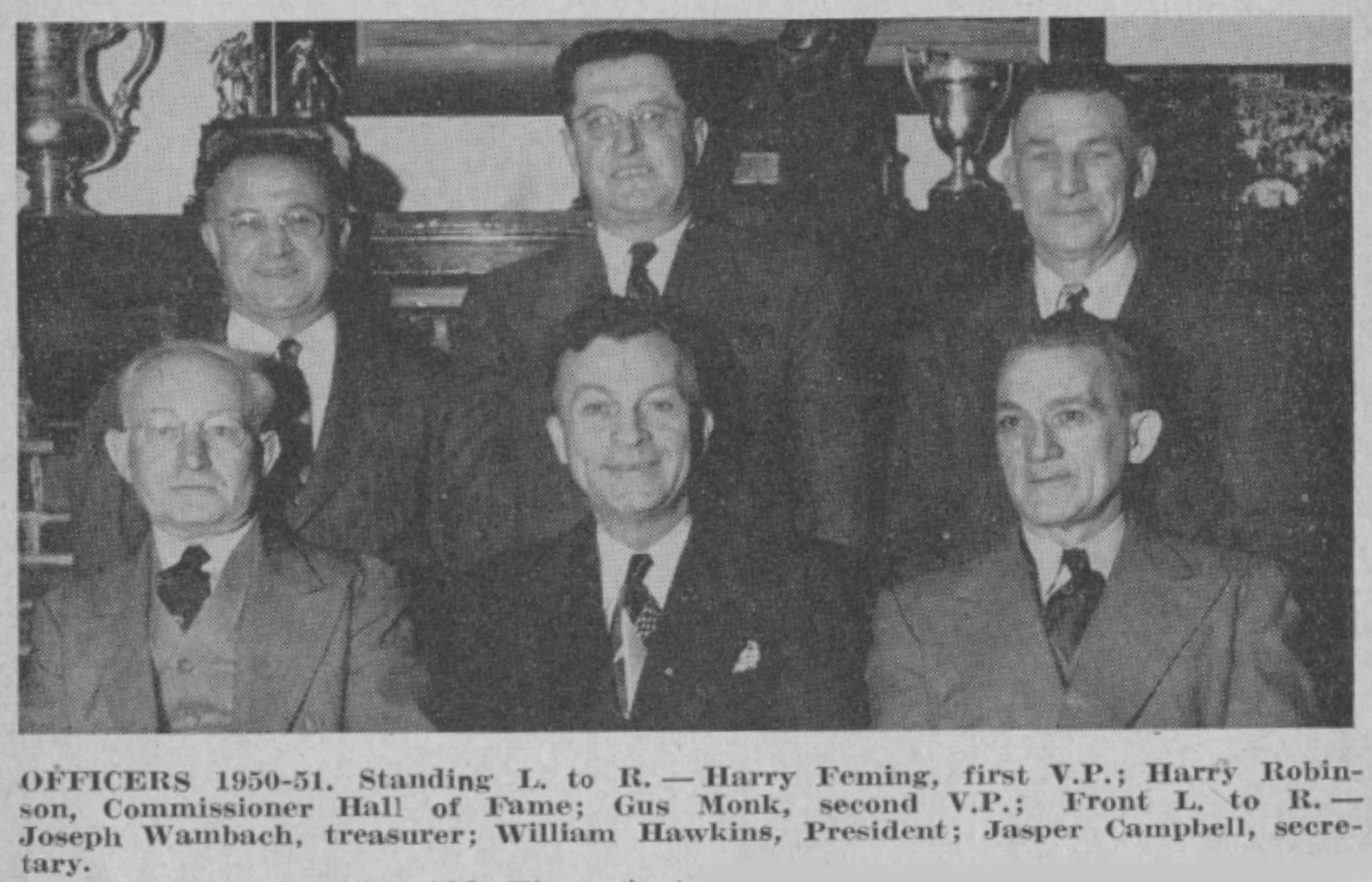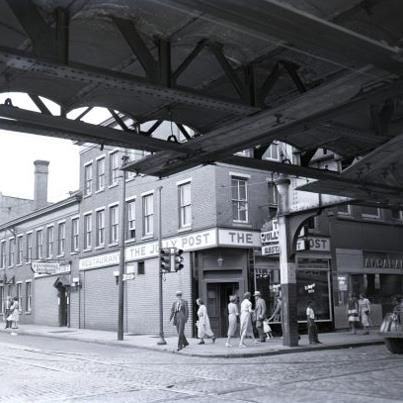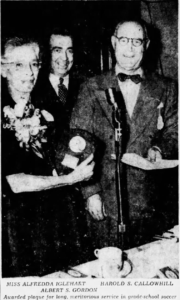
An archived page from the US Soccer website relates how the National Soccer Hall of Fame (NSHOF) “came to life in 1950” when former amateur and professional players “from the Philadelphia ‘Old Timers’ Association took it upon themselves to recognize the achievements of soccer in America.”[1]
As is so often the case when it comes to US soccer history, there’s more to the story than that.
The founding of the Philadelphia Old Timers’ Association
The Philadelphia Old Timers’ Association “grew from a sentimental idea in 1946” from Joseph Wambach and Jasper Campbell for the reunion of “players who booted” for the Merchant Shipbuilding Corporation teams of 1918-20.[2] Popularly known as Philadelphia Merchant Ship, the team finished second place in the National Association Football League’s 1918-19 season. The following season the company backed two teams: Merchant Ship A, semifinalists in the 1919-20 American Cup; and Merchant Ship B, winners of Philadelphia’s 1919-20 Allied Amateur Cup.

Wambach and Campbell soon decided to expand their team reunion idea to one that was “at least city-wide.” Campbell later explained, “With the aid of telephone directories about 100 Old Timers’ were rounded up and the reunion, with 133 attending, took place Feb. 26, 1947,” at the Jolly Post Restaurant at 4600 Frankford Avenue in Philadelphia. Money raised at the event was donated to veterans at the Valley Forge General Hospital in nearby Chester County.
Following the successful gathering, “the consensus of opinion was that an association be started.” William Hawkins was elected president, Harry Fleming and Gus Monk were elected vice president, with Wambach, treasurer, and Campbell, secretary.[3]
News of the Philadelphia Old Timers’ Association’s founding soon spread and applications for membership, soon surpassing 500, came in from Atlantic City, Baltimore, Bethlehem, Brooklyn, Camden, Chester, Fall River, Kearny, New York City, Newark, Providence, Trenton, and Wilmington “with the expressed purpose of returning the Quaker City to its former soccer glories of the early 20’s.” By 1949, attendance at the annual reunion had grown to 400. A cup was donated to the Philadelphia Midget League to help promote youth soccer and the association pushed for the inclusion of soccer in the athletic program of every school in the city. A “Most Deserving Old Timers” award was also created, with James B. Farrell honored for his work as president of the city’s Allied Soccer League, and William T. “Big Bill” Wilson recognized for his work promoting soccer in the nearby city of Chester (home now to MLS’ Philadelphia Union) and at the Merchant Shipbuilding Corporation.[4]
A Hall of Fame
From its genesis as a reunion of old teammates the Philadelphia Old Timers Association had grown into an organization working that worked to promote youth soccer in Philadelphia while actively celebrating the city’s soccer history. Thanks to its own success, the Old Timers’ celebration of local soccer history began to encompass more than the city of its founding. With this evolution “[c]ame the idea of a Hall of Fame” to be housed by the Lighthouse Boys Club. Harry Robinson was elected Hall of Fame Commissioner to manage the nomination and election process using “the recommendations of the State Associations as a guide” for determining nominees. On February 26, 1950, at the Philadelphia Rifle Club, home of the Philadelphia Americans of the American Soccer League, seven players, seven administrators, and one coach from across the country were “elected to the Shrine.” Among the players were Billy Gonsalves, Robert Millar, Harry Ratican, and Archie Stark. A further 29 were named to an honorable mention list.[5] Also honored at the event was William Tyas who, at 86, was “believed to be the city’s oldest living former soccer player.”[6]

By the time of the second Hall of Fame ceremony, the Philadelphia Old Timers numbered some 800 members. More than 400 were on hand at the Rifle Club for the awards banquet on March 3, 1951, during which 21 were named to the Hall, twelve of whom had received honorable mentions the year before. Among the new class was the first woman Hall of Famer, Alfredda Iglehart, who during her 30-year teaching career in Baltimore “taught the fundamentals of the sport to more than 1,200 boys.” Her Hall of Fame biography in the 1951-52 North American Soccer Guide began, “Proves that while this is a man’s world you can’t prove it by the women.”[7] It would be 28 years before the Hall honored another woman administrator in Margaret Fowler and 47 years before April Heinrichs became the first female player to be recognized.
At the Rifle Club on March 1, 1952, nine more names were added to the Hall. Meanwhile, the Philadelphia Old Timers inspired the formation of other similar organizations, with the New Jersey Old Timers’ Association forming in May 1952, and a hall of fame for Maryland and Washington DC — “patterned after a similar movement in Philadelphia” — inaugurated in December 1953.[8]
The Hall of Fame becomes “official”
That the Philadelphia Old Timers’ Association Hall of Fame wasn’t “official” had been noted by a St. Louis newspaper as early as November 1950.[9] This meant the Philadelphia Old Timers’ Hall of Fame wasn’t recognized by the United States Soccer Football Association (USSFA), known today as the US Soccer Federation. In the 1953-54 North American Soccer Guide, which covered events from the 1952-53 season, Bill Graham reported the Old Timers were “seeking official recognition by soccer’s National governing body.” [10] Graham reported in the Brooklyn Daily Eagle ahead of the USSFA’s 37th annual convention, “Reports to this corner back up the U.S.S.F.A. contention that the venture was worthwhile and it is believed the delegates will support a continuation of the effort.”[11] In July 1953 at the Haddon Hall Hotel in Atlantic City, the Philadelphia Old Timers’-founded soccer Hall of Fame was officially recognized and sponsorship moved to US Soccer. USSFA First Vice President Edward Sullivan of Philadelphia was named Hall of Fame chairman.[12] Sullivan continued as Hall of Fame chairman when he was elected president of the USSFA the following year.
As for the Philadelphia Old Timers’ Association’s hopes that Philadelphia would return to its soccer glories of the 1920s, Philadelphia teams — Philadelphia Americans, Philadelphia Nationals, Uhrick Truckers, and the Ukrainian Nationals — were ASL champions fifteen times between 1947 and 1970 and runners-up five times. Before it was retired in 1963, Philadelphia teams also won the league’s Lewis Cup six times with four additional second-place finishes. Over the same period, Philadelphia teams reached the US Open Cup final seven times with four championship wins. The Old Timers were surely proud of those who followed them.
Notes
[1] “National Soccer Hall of Fame: Hall History.” https://web.archive.org/web/20170312223515/http://www.ussoccer.com/about/hall-of-fame
[2] Jasper Campbell, “Philadelphia Old Timers’ Association,” in 1950-51 North American Soccer Guide, ed. Bill Graham (Brooklyn: William Graham, 1950), 13.
[3] Campbell, 13.
[4] Campbell, 14.
[5] Campbell, 14; Bill Graham, “15 Soccer Aces Named to Hall of Fame Shrine,” Brooklyn Daily Eagle, Feb. 1, 1950, 20.
[6] George Butz, “Soccer Stas Named to Hall of Fame,” Philadelphia Inquirer, Feb. 19, 1950, S5.
[7] Bill Graham, “Old Timers’ Association,” in 1951-52 North American Soccer Guide, ed. Bill Graham (Brooklyn: William Graham, 1951), 11-12.
[8] Bill Graham, “Old Timers’ (New Jersey) Association,” in 1953-54 North American Soccer Guide, ed. Bill Graham (Brooklyn: William Graham, 1953), 19; Walter Taylor, “Fame Hall Plans Set,” Evening Sun (Baltimore), Nov. 16, 1953, 30.
[9] Dent McSkimming, “Pro Soccer at High Point In Kutis-Zenthoefer Game,” St. Louis Post-Dispatch, Nov. 12, 1950, 61.
[10] Bill Graham, “Old Timers’ Association,” in 1953-54 North American Soccer Guide, ed. Bill Graham (Brooklyn: William Graham, 1953), 16.
[11] Bill Graham, “USSFA Group Cards Annual Confab Monday,” Brooklyn Daily Eagle, July 3, 1953, 12.
[12] John Nesbitt, “Hall of Fame,” in 1954-55 North American Soccer Guide, ed. Bill Graham (Brooklyn: William Graham, 1954), 45.

Pingback: The life — and murder — of the first American-born president of U.S. Soccer – Society for American Soccer History